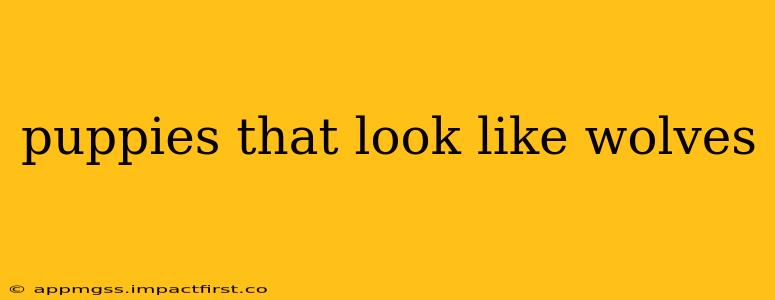The allure of a wolf-like puppy is undeniable. Their striking features, often combining wild beauty with the playful charm of a pup, capture the hearts of many. But achieving that "wolf pup" look requires understanding the breeds that share these striking similarities. This guide explores several breeds known for their wolf-like appearance, highlighting their characteristics and temperaments.
What Dog Breeds Look Like Wolves?
Several breeds bear a remarkable resemblance to wolves, often due to their size, coat color, and facial structure. It's important to note that while these breeds might look like wolves, they are still domesticated dogs with their own unique needs and temperaments. Let's explore some of the most popular breeds known for their wolf-like appearance:
1. Czechoslovakian Wolfdog:
This breed is arguably the closest you'll get to a domesticated wolf. Bred from a cross between Carpathian wolves and German Shepherds, the Czechoslovakian Wolfdog boasts a striking resemblance to its wild ancestor. They possess a lean, muscular build, a bushy tail, and a distinctive wolf-like coat. Their intelligence is high, but they require experienced owners due to their independent nature and strong prey drive.
2. Tamaskan Dog:
Developed to resemble the Alaskan Malamute and the Siberian Husky, the Tamaskan Dog is another breed that captures the wolf-like essence. They are known for their beautiful, thick coats, often in shades of gray and white, and their striking, alert eyes. Tamaskans are highly intelligent and require plenty of exercise and mental stimulation.
3. Northern Inuit Dog:
The Northern Inuit Dog is a breed specifically developed to resemble the Arctic wolf. They share a similar physical structure, often showcasing a magnificent white, gray, or black coat. These dogs are highly intelligent, loyal, and require substantial exercise to maintain their physical and mental well-being. Their strong pack mentality makes them thrive in families, but early socialization is crucial.
4. Utonagan:
Often mistaken for wolves in the wild, the Utonagan is a relatively new breed developed from a mix of Alaskan Malamute, Siberian Husky, and German Shepherd. They possess a thick, double coat, usually in shades of gray and white, and a strikingly wolf-like build. Like other wolf-like breeds, they require significant exercise and mental stimulation.
5. Saarloos Wolfdog:
A cross between a German Shepherd and a wolf, the Saarloos Wolfdog stands out with its striking resemblance to its wild relative. They possess a characteristic wolf-like gait and are known for their independent and often reserved nature. These dogs need experienced owners who understand their specific needs and can provide consistent training and socialization.
Are Wolf-Dog Hybrids Legal?
H2: Are Wolf-Dog Hybrids Legal?
The legality of owning wolf-dog hybrids varies significantly by location. Some regions have outright bans, while others may have restrictive regulations concerning permits, licensing, and specific breed limitations. Before considering a wolf-dog hybrid, it is crucial to research and comply with the local laws and regulations in your area. Failure to do so can result in significant penalties.
Do Wolf-Like Dogs Make Good Family Pets?
H2: Do Wolf-Like Dogs Make Good Family Pets?
While many breeds resembling wolves are devoted and loyal companions, they require experienced owners. Their high intelligence and strong prey drive necessitate consistent training, socialization, and significant exercise. Their independent nature might not suit every family dynamic, and their need for mental stimulation is substantial. Thorough research and careful consideration are vital before bringing a wolf-like dog into your home.
How Much Exercise Do Wolf-Like Dogs Need?
H3: How Much Exercise Do Wolf-Like Dogs Need?
These breeds typically require a significant amount of daily exercise. This includes long walks, runs, and opportunities for mental stimulation through games and activities. Failure to provide enough exercise can lead to behavioral problems, such as destructive chewing or excessive barking. Their energy levels are considerable, and owners must be prepared to meet these demands.
Conclusion:
The allure of a wolf-like puppy is strong, but responsible ownership is paramount. Understanding the specific needs, temperament, and legal considerations associated with each breed is crucial before welcoming one into your life. Remember, these dogs require dedicated owners who can provide the necessary training, socialization, and exercise to ensure a harmonious and fulfilling relationship for both pet and owner. Choose wisely, and always prioritize the well-being of the animal.
